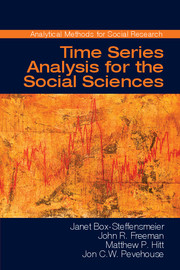Book contents
- Frontmatter
- Dedication
- Contents
- Preface
- 1 Modeling Social Dynamics
- 2 Univariate Time Series Models
- 3 Dynamic Regression Models
- 4 Modeling the Dynamics of Social Systems
- 5 Univariate, Nonstationary Processes: Tests and Modeling
- 6 Cointegration and Error Correction Models
- 7 Selections on Time Series Analysis
- 8 Concluding Thoughts for the Time Series Analyst
- Appendix Time Series Models as Difference Equations
- Bibliography
- Index
5 - Univariate, Nonstationary Processes: Tests and Modeling
Published online by Cambridge University Press: 05 December 2014
- Frontmatter
- Dedication
- Contents
- Preface
- 1 Modeling Social Dynamics
- 2 Univariate Time Series Models
- 3 Dynamic Regression Models
- 4 Modeling the Dynamics of Social Systems
- 5 Univariate, Nonstationary Processes: Tests and Modeling
- 6 Cointegration and Error Correction Models
- 7 Selections on Time Series Analysis
- 8 Concluding Thoughts for the Time Series Analyst
- Appendix Time Series Models as Difference Equations
- Bibliography
- Index
Summary
STATIONARY DATA
Thus far, all of our models assumed that our data are stationary. A stationary series does not have statistical properties that depend on time. All shocks and past values in a stationary series eventually lose their influence on the value of the variable today. A stationary stochastic process is defined such that
• A stochastic process is stationary if the mean and variance are constant overtime and covariance between two time points depends only on the distance of the lag between the two time periods and not on the actual time that the covariances are computed.
• In other words, if a time series is stationary, its mean, variance, and auto-covariance (at various lags) remain the same, no matter when we measure them.
Why should analysts care if variables are stationary? Econometric problems may occur when we run a regression with variables that are not stationary. For example, in the Box-Jenkins identification stage, because of nonstationarity, we may fail to diagnose a higher order AR process. We need to diagnose and correctly account for the characteristics of the data-generating process.
Several other issues arise with nonstationary data, which we discuss in this and the following chapters. At a basic level, nonstationary data violate the invertibility condition for the value of φ (the AR process in our ARMA model)and bias our estimate of φ (that is, the extent to which past values of the dependent variable influence the current value).
- Type
- Chapter
- Information
- Time Series Analysis for the Social Sciences , pp. 125 - 149Publisher: Cambridge University PressPrint publication year: 2014

